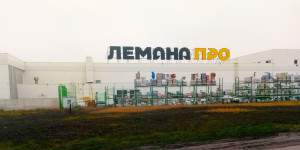The year 2001 was a particularly successful one for the DIY multiples
Are builders’ merchants less attractive to customers? This marketing channel, which generates its turnover mainly through professionals, will have to invest heavily in its stores if it wants to reach the consumer market. Higher-priced products and the reduction of the value-added tax to 5.5 per cent (instead of 20.6 per cent) have been benefiting sales to professionals for the last three years. This reduced rate of tax is only applied to products that are bought by builders and other tradesmen.
(download pdf)
Traditional trade under threat
The results for the other marketing channels were far less positive. The traditional hardware trade recorded a 6.6 per cent drop in sales, and its market share declined by 9.5 per cent to 5.9 per cent. The number of outlets of this type, which cover less than 300 m2, is steadily going down. This is because the owners have on the one hand extended their stores and joined a DIY retail group, thus contributing to the multiples’ surge of growth, or, on the other hand, been forced to close down for reasons of viability.
The supermarkets and hypermarkets are increasingly pulling back from the DIY business: sales in this segment have been going down steadily over the years. The decline in 2001 came to 2.1 per cent and their market share was not quite 9.5 per cent. “This slowdown can be explained by the fact that, although DIY remains a major product category for certain groups, others perhaps tend to favour more profitable product groups,” explains Rémy Dassant, who is responsible for market surveys at Unibal. He continued, “On the other hand, most supermarkets and hypermarkets are on the lookout for profitable and credible product assortments, since special offers have their limitations, even if they do remain lucrative.”
(download pdf)
Garden products biggest section
In DIY superstores, supermarkets and hypermarkets alike, garden products represent the main product category where DIY is concerned. They account for a good third in super-/hypermarkets (38.7 per cent), ahead of automotive/cycle supplies (20.1 per cent) and electrical/lighting (17.6 per cent). With the exception of paint/adhesives (10.2 per cent) and tools (7.5 per cent), the other DIY categories are of little significance to these marketing channels.
Garden products also play a major role in DIY superstores (13.8 per cent of turnover), ahead of the categories of plumbing/heating (13 per cent) and paint/adhesives (13 per cent). The garden sector has developed most dynamically in the DIY multiples, achieving growth of 5.3 per cent. However, after a relatively poor year in 2002, the category of plumbing/heating recorded the strongest growth, which is above the average for the DIY sector at 6.1 per cent. Excellent results were shown by the category of electrical/lighting (11.2 per cent of overall DIY multiple turnover), which recorded an increase of 5.4 per cent, and by building materials (also 11.2 per cent of overall DIY store sales) with growth of 5.2 per cent. “The growth of this product group is without doubt being furthered by the development of depot-style outlets,” in the estimation of Dassant. Still holding its own in the midfield is hardware (9.6 per cent of DIY sales) with 4.9 per cent growth. The area of timber and derived products (12 per cent of DIY multiple sales) has been confirming its continuing growth for several years now, as have paint and adhesives, which at growth of 4.2 per cent are still among the DIY superstores’ mainstays in terms of sales.
(download pdf)
Contrasting with this are tools (8.7 per cent of DIY multiple sales), with an increase of 2.5 per cent that is below average growth in the sector. Things look no better for wall and floor coverings: they account for 8.6 per cent of DIY multiple sales. With weak growth of 1.4 per cent, particularly for carpeting and synthetic floor coverings, this product category suffers from the competition of parquet and laminate, which are classified under timber and related products.
(download pdf)
Despite their weak showing, product categories such as tools and floor/wall coverings do not have any serious impact on the overall results of the DIY superstores. After the good years in 1996 and 1997, then a marked decline in 1998 and 1999, the year 2001 (and 2000 as well, by the way) showed pretty good growth for the industry. Though this positive view does not seem to be shared this year. According to information from the Fédération des Magasins de Bricolage, the French DIY retail association, the six-monthly results issued by the Banque de France for DIY multiples show a less happy sales trend: stagnant sales volumes (-0.1 per cent) are leading to growth of no more than 2.2 per cent.
DIY in Europe 9-10/2002

 Menü
Menü













